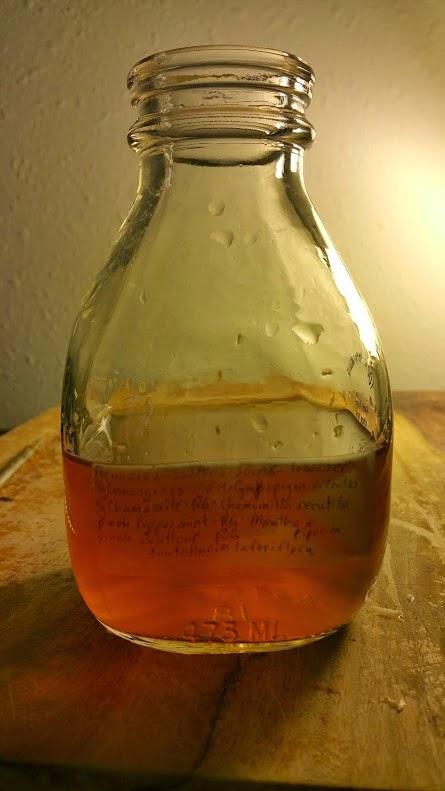For a relaxing tea blend, I chose to blend 1 part Lemongrass
(Cymbopogon citratus), 1 part
Chamomile (Chamomilla recutita), a
pinch of Peppermint (Mentha x piperita)
and a pinch of Skullcap (Scutellaria
lateriflora).
Of the four herbs, Skullcap is the
only one that I chose solely for its relaxing qualities. I do not particularly
care for the strong, bitter taste, but its sedative and nervine tonic actions (Chevallier, 2000) are enough to keep
me coming back for more.
Lemongrass, according to the Natural
Standard, is used in Brazil for “nervous and gastrointestinal disturbances,
fever, anxiety, sleep disorders, and convulsions” (Natural
Standard, 2015);
but its uplifting aroma is reason enough for me to give it a prominent role in
this relaxing blend. When it’s time to
relax, it is a good idea to surround yourself with pleasantries. It just so happens that in the case of
Lemongrass, the aroma is a result of constituents that gained the herb its popularity for use with muscle pain and conditions of exhaustion (American Botanical Council, 2013).
Chamomile also has volatile oils
giving it a pleasant, uplifting aroma. Going
back to Chevallier’s Encyclopedia of Herbal Medicine, “German chamomile, which
contains spiroether, a strong antispasmodic, eases tense muscles… relieves
irritability and helps sleep, especially in children.” There are many other uses for Chamomile, but
its sedative properties makes it a first choice for this relaxing tea
blend.
Last, but not least, this infusion
would not be complete without a hint of Peppermint, which serves many purposes. Remember the bitter taste
of the Skullcap that was mentioned in the beginning? Peppermint does a great job of tucking that
bitter taste away where it belongs. Its
essential oil is also known to uplift the spirit – simultaneously stimulating the
circulation and relaxing the nerves (Ransom, 2014).
Using these four herbs, I made a hot infusion (tea) and a solar infusion (kind of).
For the hot infusion, I used 2g
Lemongrass, 2g Chamomile, a pinch of Skullcap, a pinch of Peppermint, and 1 cup
of hot water.
It was lovely, but a little too
delicate for my preference. Perhaps 3 or
4 grams of Lemongrass and Chamomile would have put it where I’d like it to be. I think I'll add some Stevia leaves next time, too.
Next, I made what I like to call a
faux-lar infusion. I used the same herbs, only instead of 2g each of Lemongrass and Chamomile, I used 4g; and a pinch of Skullcap and Peppermint. Behold:
Unfortunately, I am running a little short on sun and heat, so I set
up an aquarium and lined three of its walls and the base with aluminum
foil. The clear wall is set up to face a
south-facing window. I also clipped a
grow lamp to the lip of the aquarium and placed a heating pad under the
aquarium.
*The Sage and Lemongrass in the Ball jar is not part of this
assignment.
3.5 hours later…
You might notice that it looks shaken at the top. Shortly after I took a picture of the label (two pictures above this one),
I noticed that some of the herb seemed like it wasn’t saturating, so I shook
it. At that moment, the sight of the plant matter clinging to the sides of the glass struck me with instant regret. Don't do what I did. The water will soak up the plant material.
I squeezed out what I could and I’m satisfied with the
resulting amount of liquid.
I am surprised that this tea turned out as strong as it
did. I was expecting a weaker
infusion. I’d like to try this again when more natural light and heat is available. When I
do, I am going to add another gram of Chamomile to bring out the flavor
more. What surprises me about this blend is that the smell of
Chamomile is stronger than its taste.
If only I could post the aroma - it is heaven in a glass!
Time to enjoy!
American Botanical Council. (2013). Lemongrass.
Retrieved from American Botanical Council:
https://my.muih.edu/?page_id=1511#param.wapp?sw_page=@@@@@@ceHome%3Fufgp%3DMonographs/Monograph0226.html
Chevallier, A. (2000). Skullcap. In Encyclopedia
of Herbal Medicine (p. 135). London: Dorling Kindersley.
Chevallier, A. (2000). German Chamomile. In Encyclopedia
of Herbal Medicine (p. 80). London: Dorling Kindersley.
Natural Standard. (2015). Lemongrass: Natural
Standard professional monograph. Retrieved from Natural Standard:
https://0-naturalmedicines.therapeuticresearch.com.muih.iii.com/databases/food,-herbs-supplements/l/lemongrass/professional.aspx
Ransom S. 2014. Peppermint. Dr. Christopher's Herbal
Legacy. Retrieved from http://www.herballegacy.com/Ransom Medicinal.html







No comments:
Post a Comment